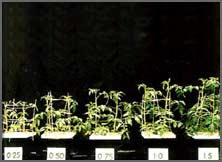Biosphere Contents
5. Development
Each species has a distinct niche, defining the conditions and resources it requires, across multiple environmental gradients

A wide range of factors control the success of plant species: soil conditions, grazing regimes and climate are obvious examples. Many of these factors can be represented as intensity gradients ranging from great to small, severe to non-existent. These are called environmental gradients. Each species will have its own optimum point on each environmental gradient. As the plant moves away from the optimum point the conditions become less favourable. Plants may suffer from stress when environmental conditions are sub-optimal, but a fatal stress for one plant species could be survivable by another. For example, for species adapted to the tropical forest biome, a single night of frost might prove fatal whilst in the temperate forests, species have developed frost resistance and moderate frost would have little effect.
The combination of an organism's tolerances and requirements is known as its niche. Proposed by Hutchinson in 1957, the niche of a species is defined across multiple environmental gradients, plus other dimensions corresponding to factors such as the type of food it requires. The niche defines the role of a species in its community.
The ability of a species to succeed depends not only on its own environmental tolerances (its fundamental niche) but also on the conditions that other potential competitors are able to tolerate. For example, many species found in nutrient-poor chalk grasslands would thrive in more fertile soil conditions if they had no competition, but in practice they are out-competed in these conditions by faster-growing grasses, so they only persist in sites where soil nutrient levels are too low for the faster-growing grasses to survive (this is their realised niche).
What is a niche?